The Earthshot Winners 2024 showing us the way

In ancient times, we would gather around village campfires, listening to our wise elders tell us stories of wonder and inspiration—or so I imagine. Fast-forward a few thousand years, and many of us might have been harangued by fiery preachers offering Hell, Fire, and Damnation if we had failed to toe the line.
Today, we hear about the woeful state of the planet, rampant greed, wars and injustices as we enter a new and relentlessly dark age, or so it seems.
Most of us feel powerless in the face of this doom and gloom. We can either turn off the news and plough on with our daily lives, hoping that someone or something else will solve our problems, while we become ever more despondent. Or we can listen to positive stories that offer hope for a way forward. Who knows, inspired by these Earthshot winners, we might have a germ of an idea that can uplift communities and spread further afield as part of civilisation’s movement into the light.
In this article, we’ll examine the Earthshot organisation and the five 2024 Earthshot Prize Winners through a regenerative business lens. They all deserve our praise and thanks, but two stand out to me in particular through my regenerative business lens.
Earthshot has proved its worth in a short space of time
While I was aware of the Earthshot Prize, I did not examine it in more depth until this year’s (2024) Earthshot awards ceremony, which took place in Cape Town. Apart from William the Prince of Wales, who is its active figurehead, founder, and president, what attracted me was that most prize winners and runners-up are innovative regenerative organisations, the focus of my research.
Another reason is that the Earthshot organisation’s vision is positive, demonstrating faith in the ingenuity of humanity to solve seemingly intractable challenges and find solutions to the polycrisis:
’Urgency + Optimism = Action.’
Each year, five winners mapped to five missions are awarded a prize of £ 1 million each. The funds are drawn from a team of impact investors and the Global Alliance, a network of philanthropic organisations supporting initiatives worldwide. Earthshot’s ten-year goal is to reduce CO2 emissions by 40% by 2030, protect 30% of the natural world on land and in the oceans, and identify talented people with potentially scaleable solutions.
The five mission areas are:
- Protect and restore nature
- Clean the air we breathe, reaching WHO standards at a minimum
- Revive our oceans
- Build a waste-free world and shift to a circular economy
- Fix the climate through carbon and greenhouse gas reductions, and develop carbon-neutral economies supporting thriving communities worldwide.
Regenerative businesses: ethically oriented and exhibit five characteristics
Regenerative businesses: ethically oriented and exhibit five characteristics
After twenty-one months of researching the domain of regenerative business within the broader context of climate change and social fairness, I have found several common characteristics. There may be others, but these stand out to me. (See Figure 1)
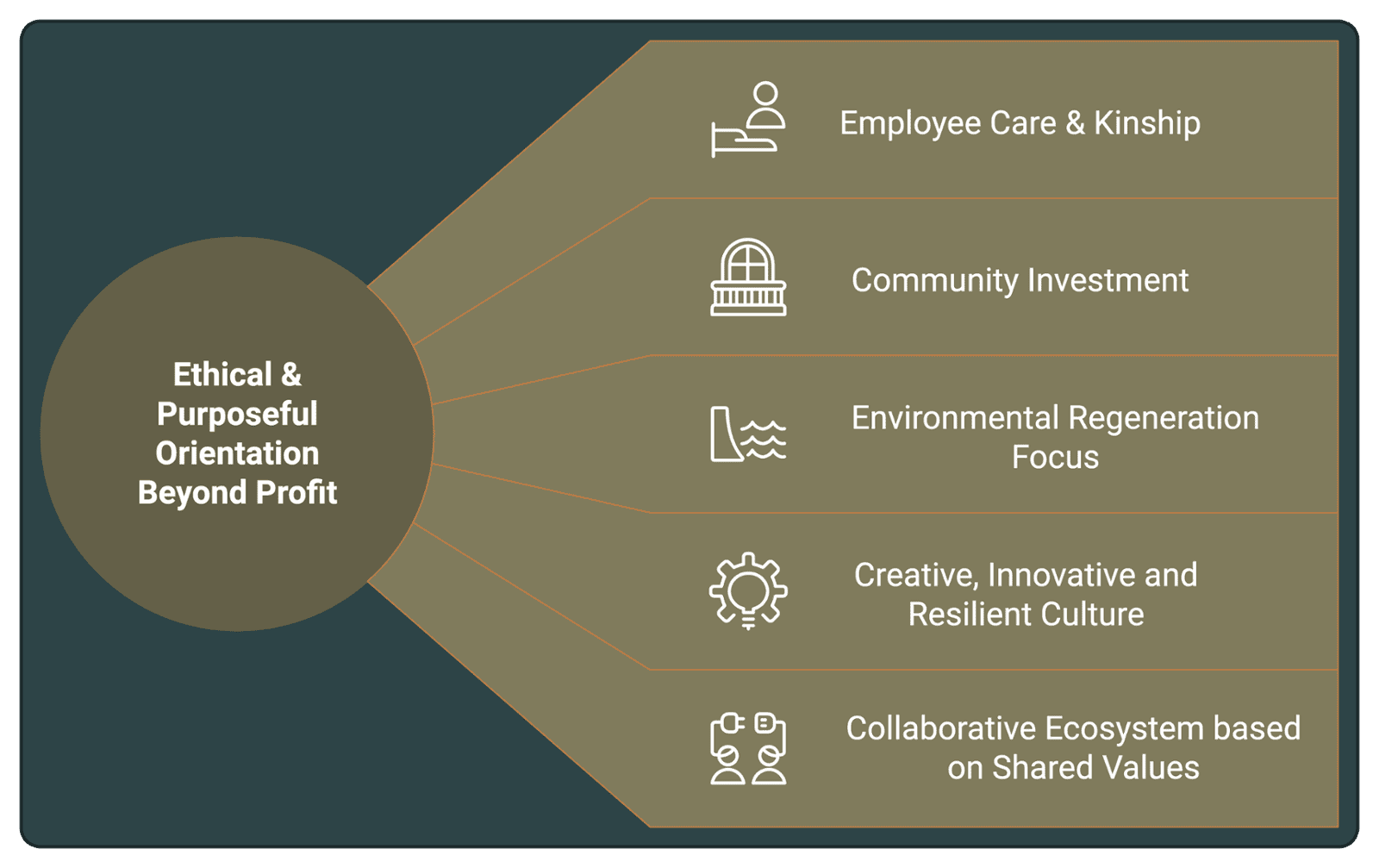
The foundation of a regenerative business is built on ethical values and a purposeful orientation that goes beyond profit. Five common characteristics support this foundation:
- Employee care and kinship: The business owners and leaders greatly respect their employees and do their best to help them flourish and develop. Employees feel wholly engaged in their common purpose and are encouraged to demonstrate initiative and participate in the continuous innovation process. They feel a strong sense of kinship and attachment to the firm, knowing their contribution is essential.
- Community investment Regenerative businesses value the communities they work amongst and invest in them. There is a symbiotic relationship between the firm and the communities they inhabit.
- Environmental regeneration focus Beyond ESG, the organisation seeks to improve the environment and eliminate waste as much as possible. It returns more than it takes from the environment. A positive contributor to a healthy environment.
- Creative, innovative, and resilient culture Creativity is valued, and a high proportion of profits is reinvested in innovation to execute the organisation’s purpose. Creativity, innovation and adaptability ensure organisational resilience. As espoused by Mariana Mazzucato in her book Mission Economy ‘’A theory of innovation needs to be nested in a theory of learning, experimentation and adaptation to uncertainty.’’[1]
- Collaborative ecosystem based on shared values Regenerative companies recognise that affecting regenerative change requires an ecosystem of stakeholders and partners. The ability to collaborate and co-create is an essential attribute.
Each of the five Earthshot winners exhibits these characteristics to a greater or lesser degree. We’ll now take a closer look before my subjective evaluation.
First up in alphabetical order is: Altyn Dala Conservation Initiative.
Altyn Dala Conservation Initiative - Protect and Restore Nature Winner
Altyn Dala Conservation Initiative - Protect and Restore Nature Winner
A group of conservationists and the government of Kazakhstan began the collaborative Altyn Dala Conservation Initiative to save the endangered Saiga Antelope, pictured below.
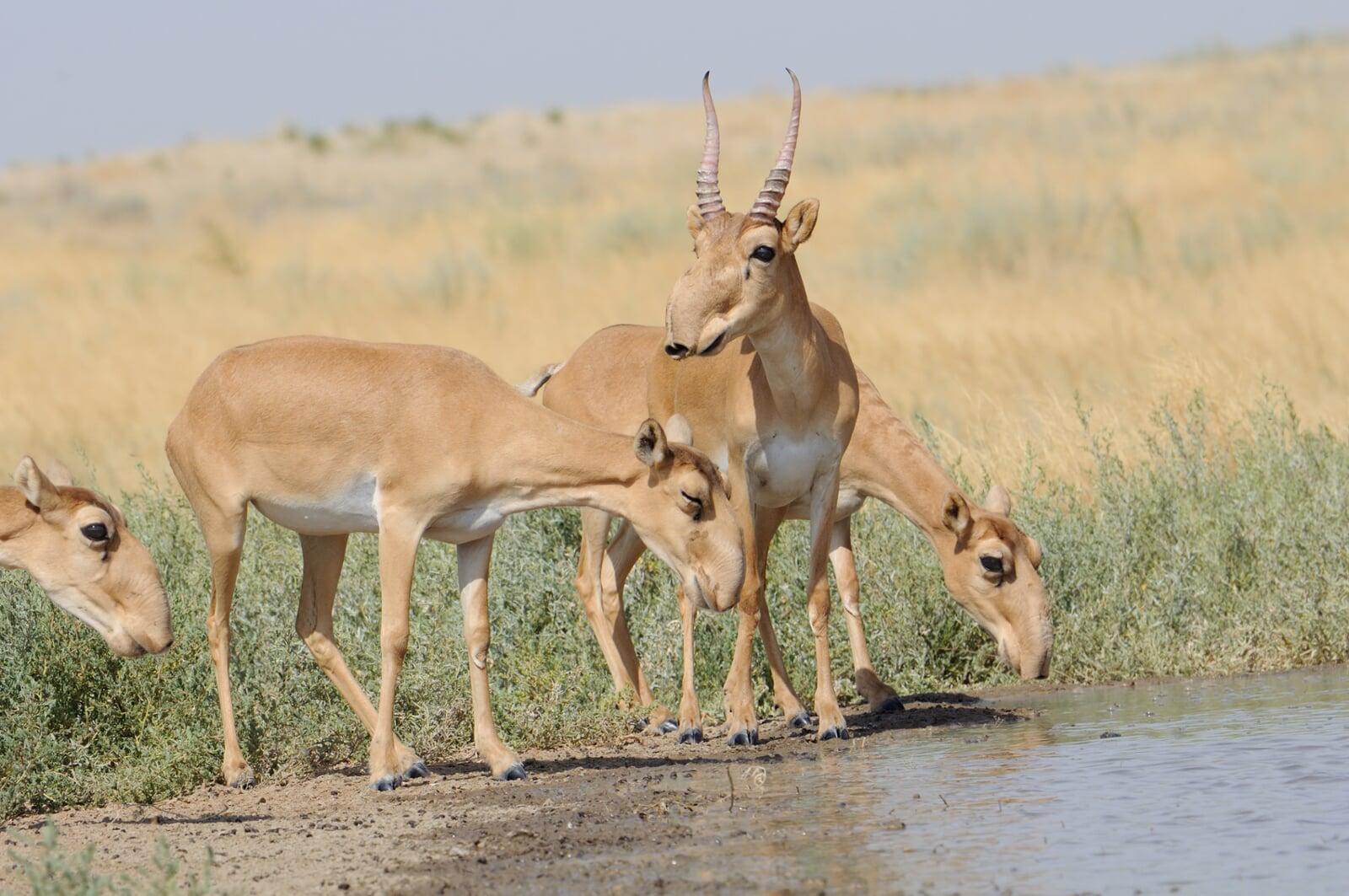
The antelope is threatened with extinction on the ancient Kazakh steppe in Central Asia, the world’s largest expanse of temperate grassland. Since then, restoring Kazakhstan’s Golden Steppe has become one of the world’s most expansive conservation projects.
For thousands of years, nomadic herdsmen wandered the steppe in harmony with nature, finding pastures for their cattle and escaping the harsh winter and summer seasons, during which temperature extremes ranged from -40C to +40C.
Once part of the Soviet Union, large swathes of the steppe were devoted to intensive farming, which degraded both the grasslands and biodiversity. After the fall of the Soviet Union, farming subsidies disappeared, and many farmers left to find work elsewhere. Since the 1990s, the Saiga antelopes have been threatened by the loss of pastures from intensive farming and climate change and decimated through poaching. Their numbers fell to critical levels. In 2015, excessively warm conditions triggered a bacterium that wiped out 60% of the Saiga.
An international collaborative ecosystem
That same year, Executive Director Vera Voronova headed the Altyn Dala Conservation Initiative, led by the Association for the Conservation of Biodiversity of Kazakhstan (ACBK). This international collaboration, which receives financial and technical assistance from Fauna & Flora (F&F), Frankfurt Zoological Society (FZS), and the Royal Society for the Protection of Birds (RSPB), is in partnership with the Committee of Forestry and Wildlife of the Government of Kazakhstan's Ministry of Ecology and Natural Resources.
The Altyn Dala Initiative has had remarkable success
In 2003, the Saiga antelope population, once numbered in tens of millions, dropped to just 20,000. In 2024, there are now over 2.86 million.
This extraordinary success has encouraged the organisation to put
5 million hectares under active conservation management, protecting and restoring the steppe to its former healthy condition and enhancing its biodiversity.
Community involvement is critical to future success
To ensure the initiative’s continued vitality, children are educated firsthand about the steppe’s wildlife and see the work of rangers and research teams in the field. Without the active support of local communities and a deep understanding of the value of this precious landscape, a conservation programme of such magnitude would never succeed. The initiative provides jobs, and it is expected that around 725 full-time staff will be needed to continue the work, creating more worthwhile jobs for the communities.
By any measure, this is an outstanding example of restoration through extensive collaboration between ecologists, government organisations, steppe rangers and local communities, all pulling together. Worthy winners of the Earthshot mission to protect and restore nature. One final observation is that the Altyn Dala Initiative has similar aims as those of the Savory Institute, founded by Allan Savory in 1984 - to save the world’s grasslands.
Advanced Thermovoltaic Systems - Fix Our Climate Winners
A staggering 60% of energy used by industrial manufacturing and heavy engineering plants is lost in waste heat - equivalent to 4 billion homes. Steel and cement production are the biggest culprits, generating enormous amounts of heat and CO2 waste.
Attempts to capture and reuse heat waste have relied on expensive, complex, noisy turbines. These turbines have many moving parts, increasing the risk of production interruption. As a result, many large manufacturers shy away from this type of waste heat energy recycling.
Advanced Thermovoltaic Systems (ATS) provide a much more cost-effective solution. It has no moving parts and consists of recyclable and replaceable components; it can easily be installed in any manufacturing plant and eliminates the risk of interruption.
Serendipitous discovery based on thermophotovoltaic energy conversion
Founded in 2007, ATS started as a solar panel company, but a lucky discovery led to a new mission: to recycle waste heat and convert it into electricity. In the morning, after the lights had been turned off the previous night, they discovered that ambient heat in the room had generated additional power. The discovery stunned them, and immediately, thoughts turned to potential uses in heavy manufacturing industries reliant on fossil fuels where CO2 emissions are prohibitively expensive to abate.
Their next challenge was designing a solution that would readily fit within any industrial plant. They created semiconductor wafers from bismuth telluride powder and cut them into small pellets to form an array in which warmth on one side and cold on the other generated electricity. The arrays, which are in the form of cards, are daisy-chained together like solar panels, but they use heat instead of light to generate electricity.

The ATS system has significant advantages over heat turbines are:
- no moving parts
- easy to install
- operate from an iPad or similar
- significantly lower costs
- easy to swap components and maintain
ATS proved the solution worked when they partnered with Holcim, one of the world’s largest building product companies with a regenerative mindset.
'We all feel a deep responsibility to deliver this technology to industry, society and the planet’ Kelly Adams, CEO, ATS.
Scaling up for the future
The firm has set its sights on scaling up production to support heavy manufacturing industries worldwide. By 2030, it expects to be operational in over 100 industrial plants and save over 3.5 million tonnes of CO2, rising to 100 million tonnes by 204 and a gigatonne by 2050.
Many hope innovation will contribute significantly to solving our climate crisis and regenerating the planet. Capturing waste heat and converting it into power in our most resource-hungry and polluting industries represents a massive step in the right direction.
GAYO - Green Africa Youth Organisation - Clean Our Air winner
According to the World Economic Forum (WEF), 60% of Africa’s 1.4 billion population is under 25 years old. It is also the fastest-growing population, expected to reach 2.5 billion by 2050, and more Africans will enter the workforce than the combined total of the rest of the world.
Rapid urbanisation is likely to accelerate as Africa’s young adults seek work.
This places enormous pressure on towns and cities to support the growing population and generate jobs, especially for those with limited access to education and skills development. The Brookings Institution, a non-profit research organisation, predicts that the greatest opportunities in Ghana, for example, will come from agri-processing and tourism, both labour-intensive sectors.
This year’s Clean Our Air Winner, Green Africa Youth Organisation (GAYO) co-founded by Desmond Alugnoa, had an even better idea to tap into the energy of young adults in Africa. One that would create employment opportunities for the young and tackle the escalating problem of city air pollution from burning waste.
Alugnoa grew up in the countryside and was shocked by the choking air pollution when he moved to Accra, Ghana. This ignited his interest in climate science. While studying for a BSc in Environmental Science from the University of Cape Coast (UCC), he met environmentalist and equality activist, Joshua Amponsem, and in 2014, the two of them founded GAYO.
The problem with rapid urbanisation in many African cities is twofold: a lack of modern waste services and an awareness of the impact of burning waste, especially plastics and tyres, or creating landfills that leach pollutants into water courses and agricultural land.
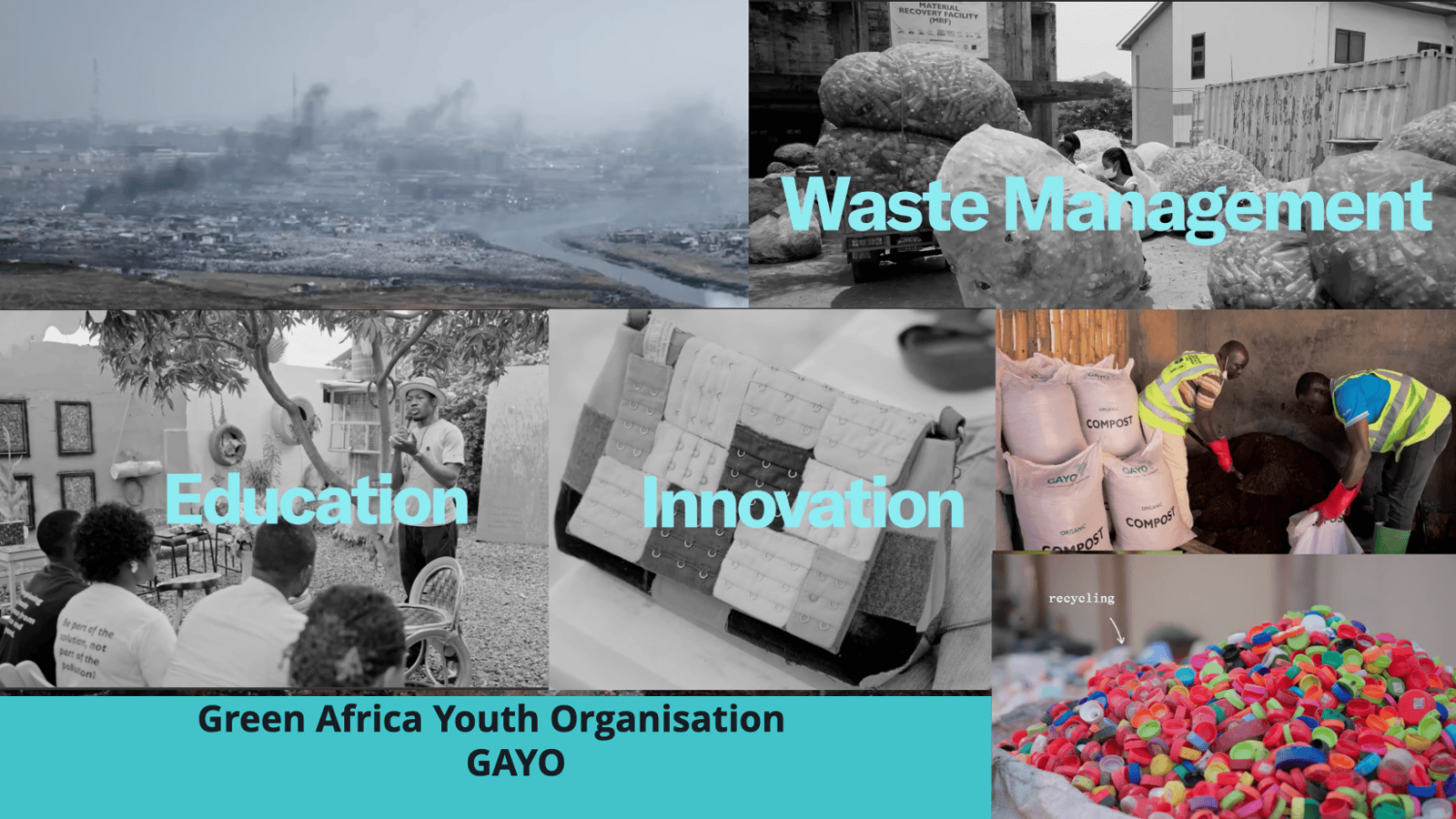
Amponsem and Alugnoa put their education to good use, and they were determined to develop a circular Zero-Waste Model, converting waste into saleable products that would employ underprivileged young men and women.
GAYO’s first break came when it partnered with the La Dade-Kotopon Municipal Assembly (LaDMA), which contributed to the ‘Zero Waste Accra Project’. This was in line with President Akufo-Addo’s ambition of making Accra the cleanest city in Africa. Miss Betty Osei Bonsu, (now Country Manager for GAYO Uganda and former Project Coordinator* for GAYO), said that one of the project’s goals was to educate the community to see waste as a resource to be used rather than burned or buried. Saleable products included charcoal briquettes, compost and furniture. GAYO also used local radio stations to advance its message about clean air to breathe and waste management. (*At the time of the Earthshot nomination, the role of Project Coordinator was and is still held by Miss Mabel Laryea).
Zero Waste Management rests on three pillars
In his video submission to the Earthshot Prize judges, Alugnoa explained that the Zero Waste Management project rests on three critical pillars:
- Waste Management
- Education and
- Innovation.
GAYO aims to solve environmental issues through youth empowerment, skills development, and public education.
In his own words regarding innovation and youthful energy, he said:
’ The best minds are the ones closest to the problem. I see energy, I see hope, I see inspiration, I see that these people become the drivers of the green revolution.’
GAYO employs and trains people from all walks of the community, including women, youths, waste collectors, and pickers. It also collaborates with waste management specialists, communities, and minority groups.
To spread the faith, GAYO partnered with Earthbeat, a youth4planet project to enhance storytelling through video. Youth4planet started in Hamburg, Germany, in 2015, showing its first video story at COP21 in Paris the same year.
Success comes from persistence
While GAYO succeeded with LaDMA, expanding the project to other areas and countries where government ministers were unused to discussing projects with the young took persistence. Nevertheless, since 2019 GAYO has created 70 green jobs in Accra for young adults, widows, single mothers and those with disabilities, benefitting over 5000 people.
In 2023, GAYO kept 170 tonnes of waste out of landfills, consisting of 104 tonnes of organic waste and 66 tonnes of plastic. It is estimated to have saved 3.6 tonnes of CO2.
So far, the project has empowered more than 3000 women, planted more than 20,000 trees, produced 40 tonnes of compost fertiliser, reached over 60,000 youths, and created over 700 jobs. It now operates in Botswana, Ghana, and Uganda.
Future expansion across Africa
Its future goal is to build a movement across Africa to drive behavioural change in waste management. By 2030 it wants to support 50% of cities in Africa, targeting Kenya, Madagascar, Morocco, Niger, Nigeria, Senegal and South Africa.
GAYO is an extraordinary, uplifting story about the power and energy of young adults who take a leadership role in Cleaning Our Air. It is a most worthy winner.
High Ambition Coalition (HAC) - Revive Our Oceans Winner
In the run-up to COP 21 in Paris, 2015, Foreign Minister of the Marshall Islands, Tony de Brum, convened the first meeting of the High Ambition Coalition (HAC) in an attempt to influence international climate negotiations. The Republic of the Marshall Islands is one of two countries in the world consisting of low-lying atolls and, therefore, vulnerable to rising seas impacted by climate change and rising seas. After his detain 2017, the leadership of HAC passed to Rita El Zaghloul, from Costa Rica, director of the High Ambition Coalition for Nature and People.
HAC, nominated by the Campaign For Nature, shares the nominator’s 30 X 30 goal of protecting and restoring 30% of land and 30% of the oceans by 2030. El Zaghloul’s leadership has been earned as part of a Costa Rican team that, after a decade of effort, has already achieved the 30x30 goal. Costa Rica and France co-chair HAC, with the UK as the oceans champion. The organisation, consisting of just eight people, acts as a catalyst, encouraging governments worldwide to establish protection zones for seas and land to protect life-supporting ecosystem services.
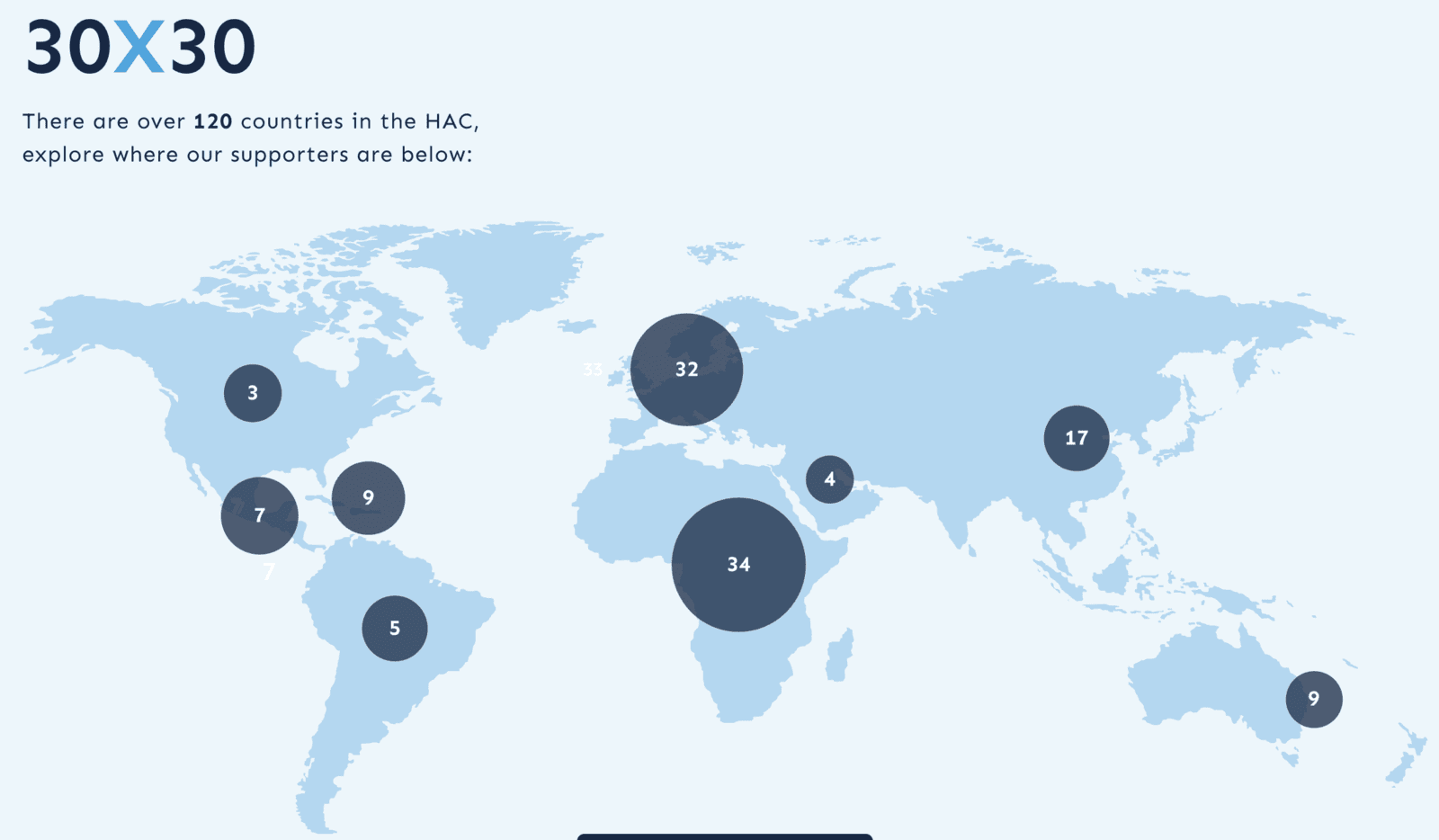
Government policymakers are critical to success, but HAC recognises that they need help and guidance to convert ambition into practical action. To this end, HAC collaborates with experts and acts as a matchmaker, introducing the most relevant expertise to governments to help them plan and act effectively. Currently, HAC supports 120 nations from all continents. Financial assistance is also provided and a solutions toolkit based on the Kunming-Montreal Global Biodiversity Framework from COP15. The toolkit includes information and best-practices guidance resources to help countries design, implement, and report on the progress of any environmental and biodiversity project.
Cost Rica proves 30x30 can be done, which inspired others
Costa Rica’s success in meeting the 30x30 goal has inspired several other countries in the Latin American region. Columbia, Panama, Ecuador, Seychelles, and the Dominican Republic are scaling their ambitions. However, HAC’s influence spans the world.
Madagascar, a biodiversity hotspot embarks on its conservation journey
A recent example is the Republic of Madagascar. The island is 250 miles from the southeastern coast of Africa and is a biodiversity hotspot , a term coined by the environmentalist Norman Myers. To qualify as a biodiversity hotspot, the country must have over 1,500 species of plants and have lost at least 70% of its primary vegetation. It also supports diverse animal and insect life that is threatened by human activities through habitat degradation. Currently, just 0.9% of Madagascar’s land and sea are protected. After a HAC workshop involving ministers, technical teams and local communities, an agreement was reached to triple protected areas by 2030.
Support for Indigenous communities and UN influence
HAC has several conservation projects involving Indigenous communities in Canada, Chile (Rapa Rui), and Australia.
- In 2019, Canada’s Thaidene Nëné became a protected national park, led by the Indigenous Łutsël K’e Dene First Nation. A close collaboration between Indigenous communities and the Crown government helped Canada reach its 2020 goal of 17% of lands under protection.
- To reach Canada’s 2025 goal of 25% of land under protection, Indigenous Canadian communities and the government established several Indigenous Protected and Conserved Areas (IPCAs).
- Rapa Sui (Easter Island) off Chile established South America’s largest multiple-use marine protected area, based on the principles of ancestral rights and environmental respect. The organisation pledged to hit the 30% marine conservation target by 2030.
- In 2013 the Federal Government of Western Australia declared Birriliburu an Indigenous Protected Area (IPA). Traditional landowners now manage the land as a protected reserve.
- The highly successful Indigenous IPA program now accounts for over 50% of Australia’s National Reserve System, protecting around 87 million hectares of land and 5 million hectares of sea. The Australian Government will invest $231.5 million over 5 years from 2023-24 to expand the programme, including funding for ten new Indigenous Protected Areas.
Many examples of progress toward the 30 x 30 goal are being made in France, Gabon, Japan, and Peru. However, more is needed. To emphasise this, HAC joined the UN General Assembly in New York this year to press the case for 30x30 and promote national and regional action and investment to protect our lands and seas. On October 29th 2024, HAC held an action day at the UN COP16 Conference of the Parties to the Convention on Biological Diversity, in Colombia.
Keep IT Cool - the Build a Waste-free World winner
Keep IT Cool’s (KIC) innovative approach ensures fish caught in Lake Victoria and its smaller sibling, Lake Turkana, remain fresh along the entire value chain, from ‘lake to plate’. Its vision is:
‘To be the leading innovator in the African supply chain industry, utilising technology and innovative business models to increase the incomes of small-scale farmers and fishermen.’
Founded in 2019 by Francis Nderitu and Abigail Gachigi, this pioneering company, using a mix of technologies, has solved a massive problem of waste and lost income for fisherfolk who often work in intense heat (40ºC) on the Kenyan side of Lake Victoria and Lake Turkana.
Without local cold storage, getting fish fresh to market is a substantial challenge under these conditions, often resulting in the loss of half the catch. The two founders applied a systems-thinking approach to understanding the challenges at each value chain stage, from the shore through distribution to fish traders, retailers, restaurants, and home cooks. A day’s drive from Lake Victoria and Lake Turkana, keeping fish fresh is no mean feat, especially as drivers often turn off refrigeration to reduce transportation costs.
Small family fishing firms are especially vulnerable
According to the Draper Richards Kaplan Foundation, a social impact investment firm that nominated KIC for the Earthshot Prize, 97% of fish landing sites in East Africa lack local access to cold-chain logistics. Small, underserved fishing firms are the most vulnerable, as they cannot afford refrigeration equipment. It often takes them two days to catch sufficient quantities of fish for sale, increasing the chances of fish losing freshness. Nor can they mitigate losses through price control, as market traders set prices. KIC prioritises these small, most at-risk fishing families while boosting environmental sustainability throughout the value chain. It does this through technology and collaborative partnerships.
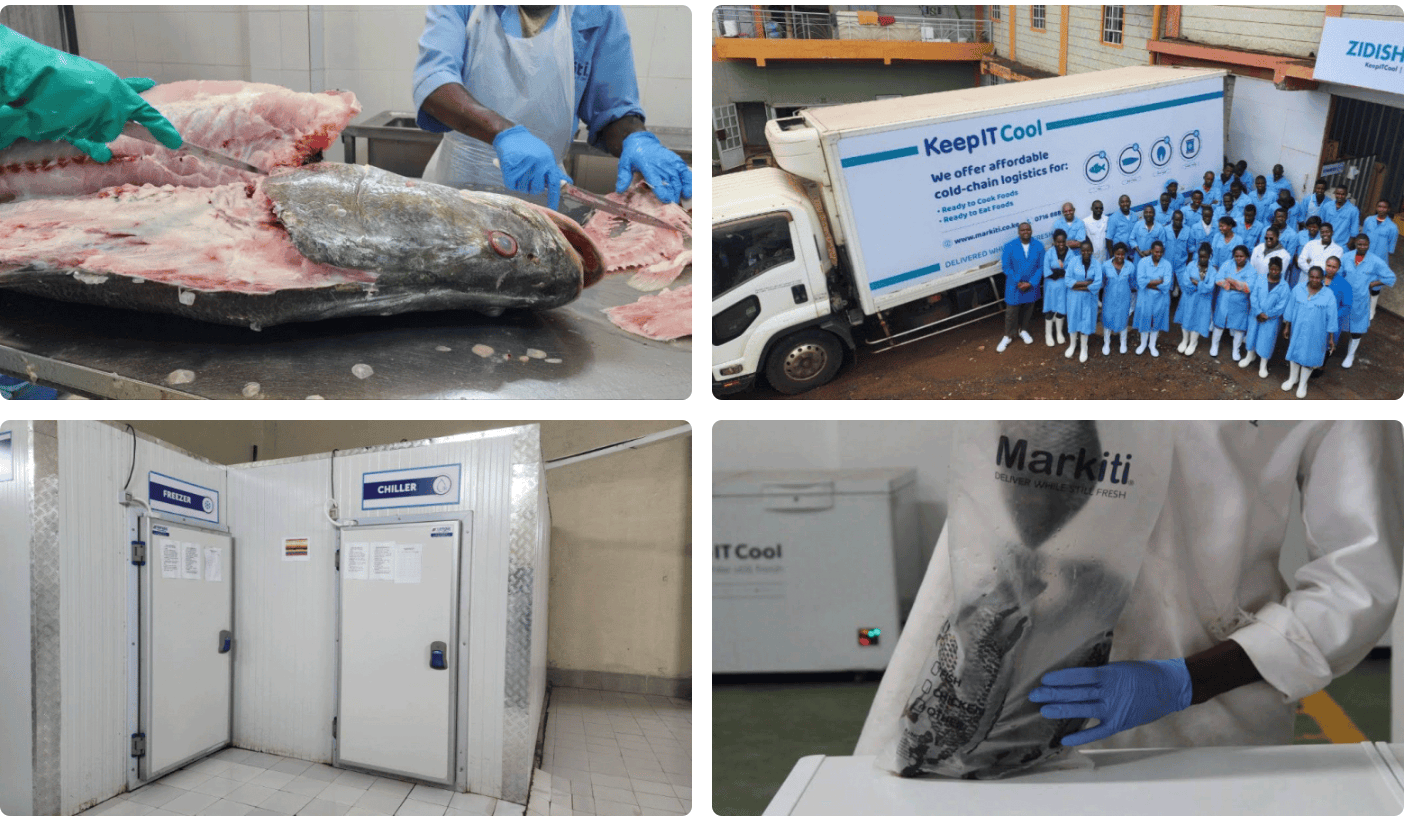
Before fish reach the landing site, they can die rapidly in high temperatures. KIC has developed a practical solution to help fishers maintain fish freshness. The company has established the Wezesha Hub, an aggregation centre close to the landing sites. The hub’s solar-powered ice production facility provides ice for cool boxes, allowing anglers to keep their catches fresh while sailing back to the landing site. The hub also provides training on sustainable fish handling and offers better fishing gear. By maintaining freshness, KIC minimises waste.
KIC provides hybrid cold-chain logistics to keep fish fresh throughout their 400 - 700 kilometre journeys to its Zidisha Hub. There, they are gutted and sorted before being transported to Sambas Hubs, KIC’s distribution outlets in several towns and cities. Once reaching its final town or city destination, the fish is kept fresh in the retail store or restaurant in KIC-supplied solar-powered freezers leased from the company with no upfront cost. Solar-powered freezers protect the retailer or restaurant owner from losses due to an unreliable electricity grid.
CIC’s trading and logistics platform matches supply and demand
KIC developed a trading and logistics platform, taking advantage of Google technology. The platform, ‘Markiti’, enables KIC to match demand and supply and optimise the entire fish supply chain. Today, KIC has agreements with 1,600 retailers and works with eight fisherfolk cooperatives representing 4,500 members.
Keep IT Cool ventures into poultry, creating opportunities for women
While the early years have focused on fish and helping small fisherfolk earn a better living, KIC has moved into the poultry sector in 2022, applying a similar approach and generating a positive impact, especially among women.
Housewives have been empowered to do more than manage a few chickens for their family needs. They can now participate in the poultry market, raise more than one flock of chickens, and sell what they don’t need for their families to KIC. As a result, the average monthly income for these women has more than tripled, from the equivalent of $80 to $300. In partnership with a vet, KIC also provides education on sustainable farming practices and how to breed healthy, antibiotic-free chickens. As with fisherfolk, this emergent class of farmers is paid immediately.
Keep IT Cool, making a substantial impact towards a waste-free world.
According to KIC, the company has achieved the following:
- Supplied over 1,965 tonnes of fresh fish and poultry.
- Boosted incomes by 20% for fishers and poultry farmers
- Supports 2,706 retailers, 350 of which use KIC freezers
- Cut carbon emissions by 51%
- Improved the livelihoods of 31,550 individuals
- Reduced food waste by preserving 25% - 50% of fish harvests
- Diverted 96 tonnes of fish offcuts from landfills and upcycled 17 tonnes of chicken waste for manure.
- KIC has created 100 direct jobs and over 500 for youths.
KIC aims to expand across East Africa and diversify into fruit and vegetables. A phenomenal success and worthy Earthshot Winner.
Final observations through the regenerative business lens
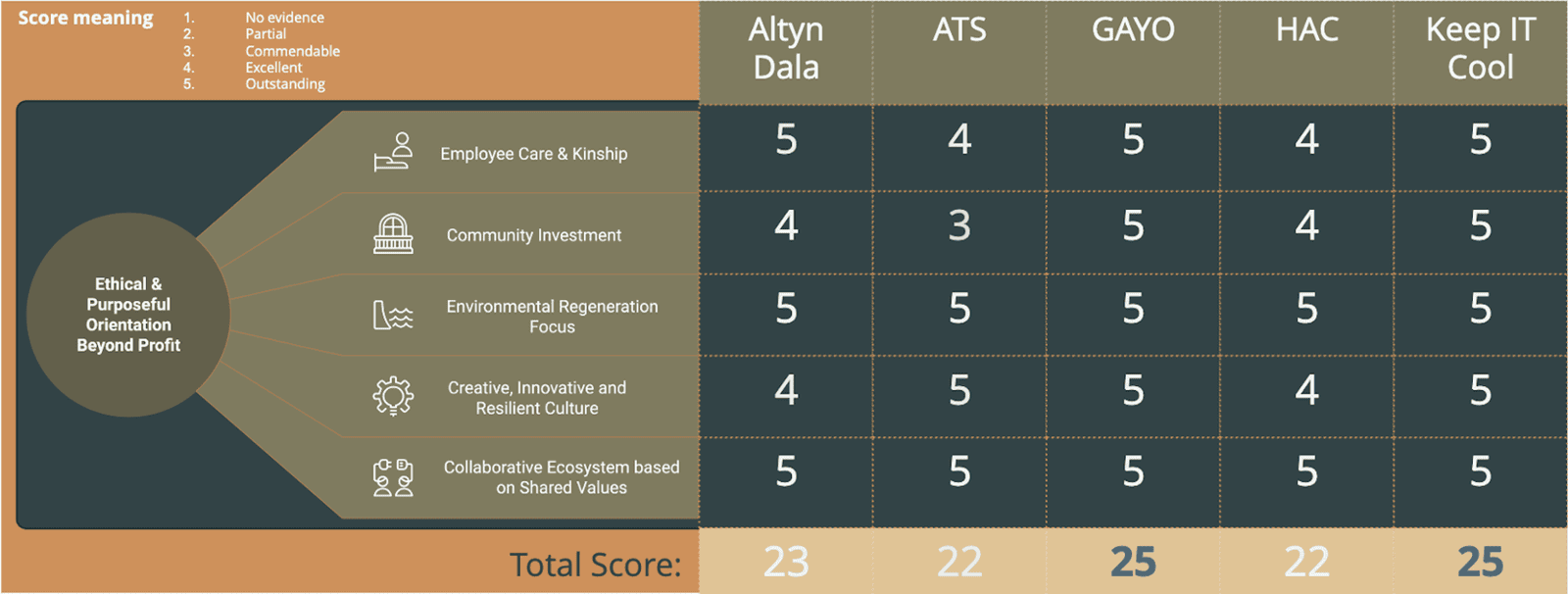
Each of the five winners is a remarkable and inspiring example of a regenerative organisation. Altyn Dala and High Ambition Coalition (HAC) are NGOs rather than strictly businesses, although each has high scores exhibiting regenerative attributes. The other three are regenerative businesses, and the two standouts are GAYO and Keep IT Cool, which have proven their claim to maximum points.
As ATS scales up its production facilities, it can choose to invest in communities that will benefit most from employment.
As for the Earthshot Prize, I confess to being a convert. We desperately need more uplifting stories like these to make us realise that the world can be healthier and create opportunities for all, no matter their background. This is my chief goal with Orbis Sacri.
- Regenerative Business - It’s a Matter of Consciousness
- Transition Network - a mycelial catalyst inspiring hope and community regeneration globally
- Zoho the Regenerative Company - In Spirit, by Design and in Practice
- Anglo American - Even Extractive Companies can become Regenerative
- The Handmade Bakery - A Community-sponsored bakery regenerates life in an old mill town in Yorkshire
- What can four wise men born in the 19th Century teach us about a regenerative future?
